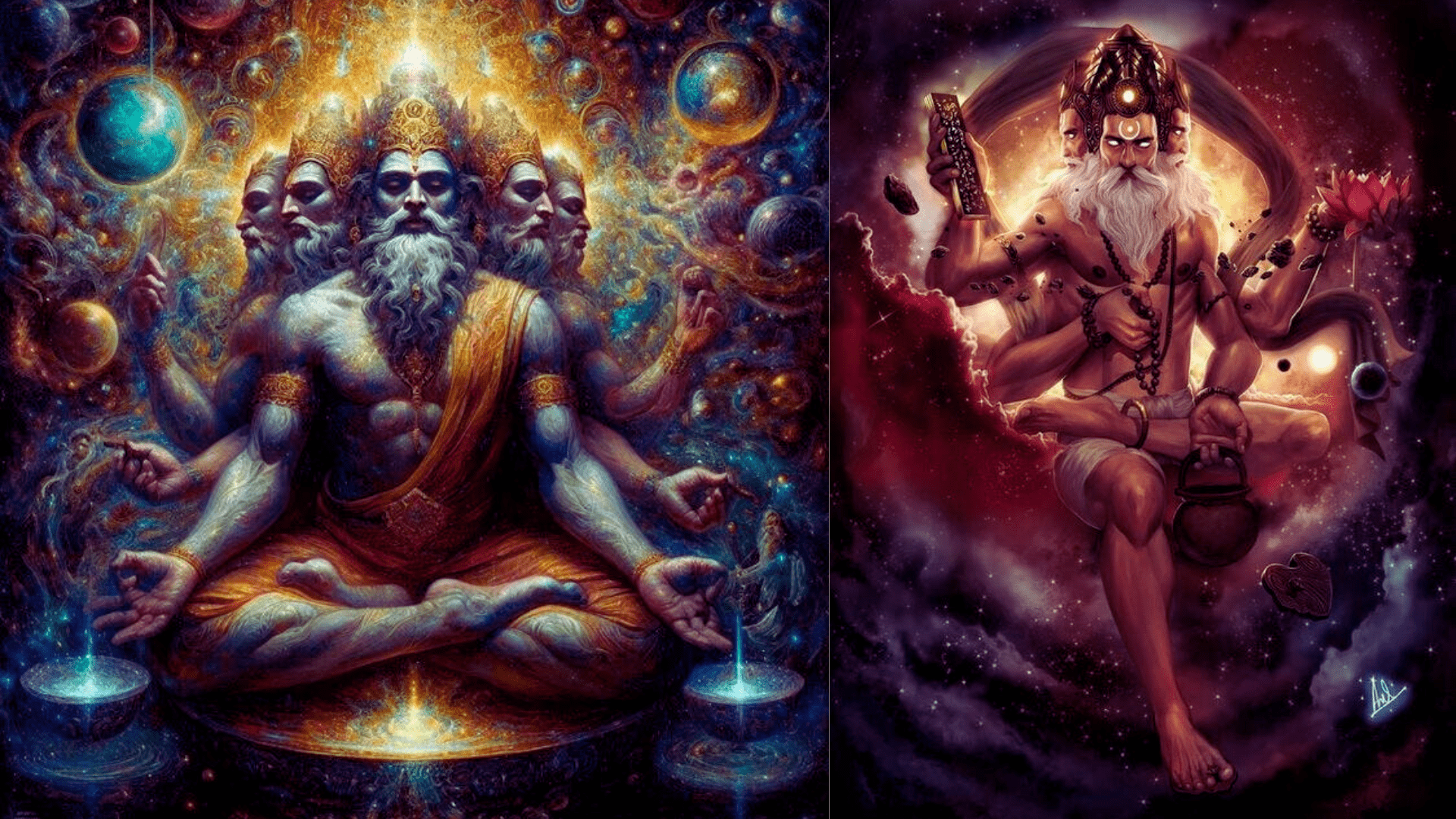Brahma, in Hinduism, represents the first member of the Trimurti, embodying the role of the creator. Emerging from a period roughly between 500 BCE and 500 CE, Brahma was once among the pantheon’s most revered deities. However, over time, his prominence waned, overshadowed by gods such as Vishnu, Shiva, and the great Goddess. Despite this, Brahma’s foundational contribution to the cosmos—as the architect of the universe and all living beings within it—remains a critical aspect of Hindu cosmology.
Traditionally depicted with four heads, Brahma is seen as the source of all knowledge and creativity, responsible for the creation of the universe and the cyclic aspect of time. His myths, such as the Brahma’s Creation Myth, illustrate his paramount role in bringing forth existence from chaos. Although his worship today is less widespread than that of Vishnu and Shiva, Brahma remains a symbol of limitless creativity and the intellectual fountain from which all worldly and divine knowledge flows.
The Origins of Brahma
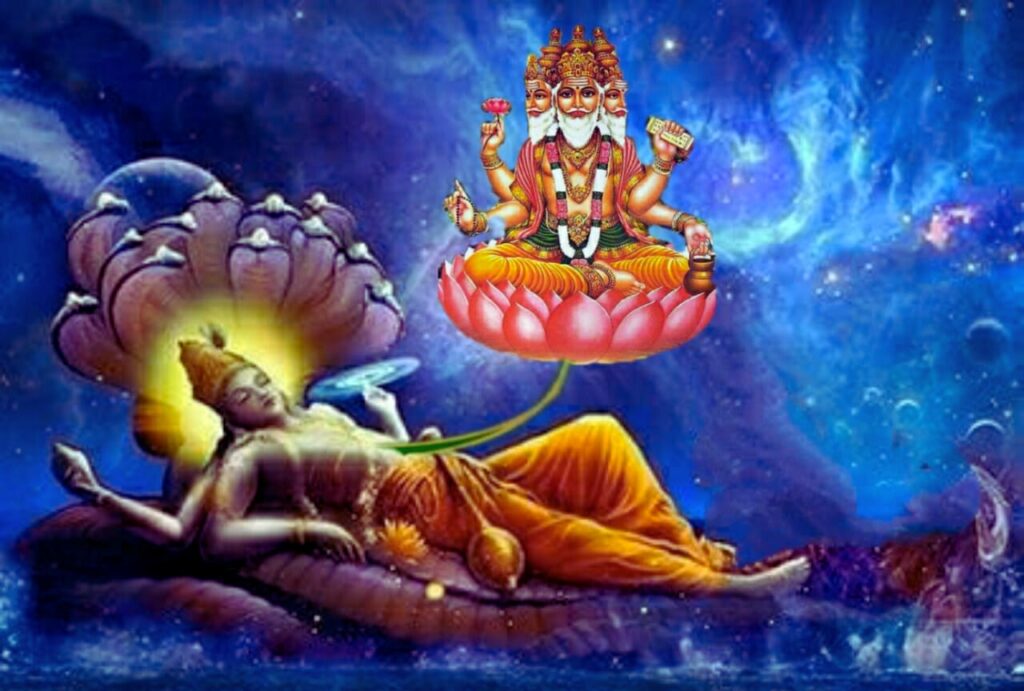
Brahma, the Hindu god of creation, has several myths concerning his origins, which highlight his significance within Hindu mythology. One prevalent narrative describes Brahma as emerging from a cosmic egg, known as Hiranyagarbha, symbolizing the birth of the universe itself. In this account, Brahma is manifested as a golden lotus flower from the cosmic egg, marking the beginning of creation.
Another prominent story depicts Brahma being born from a lotus that arose from the navel of Lord Vishnu, who is resting on the cosmic serpent, Shesha. This imagery reinforces the interconnectedness of the major deities within Hindu cosmology and emphasizes Brahma’s role in the creation process. Some Puranas elaborate further, suggesting that Brahma created himself in the Hiranyagarbha or the golden embryo, underscoring his self-born nature and autonomous creative power. These myths collectively illustrate Brahma’s pivotal role as the creator of the universe and all living beings, embodying the essence of knowledge and creation in Hindu theology.
Significance in Hindu Texts
Brahma, one of the principal deities in Hinduism, is deeply rooted in the sacred texts of the Vedas and Upanishads, symbolizing the creation aspect of the universe. The Vedas, revered as the oldest scriptures of Hinduism, were revealed to the world by Brahma. These texts, including the Upanishads, are a commentary on the Vedas and delve into philosophical discussions about the universe, the nature of Brahman (the ultimate reality), and the soul. Brahma and his Composition Saraswati are embodiments of knowledge and represent the Vedas and their essence, featuring prominently in Hindu literature. The Upanishads further explore the concept of Brahman, often describing it as the unmanifest reality beyond human perception, and Brahma is associated with this ultimate reality in various texts. Additionally, the Brahma Upanishad, one of the texts, specifically discusses the omnipresent and omniscient aspects of Brahman, linking these attributes closely with Brahma. This integration of Brahma in the Vedas and Upanishads underscores his fundamental role in the creation narrative and the broader philosophical discourses in Hinduism.
The Iconography of Brahma
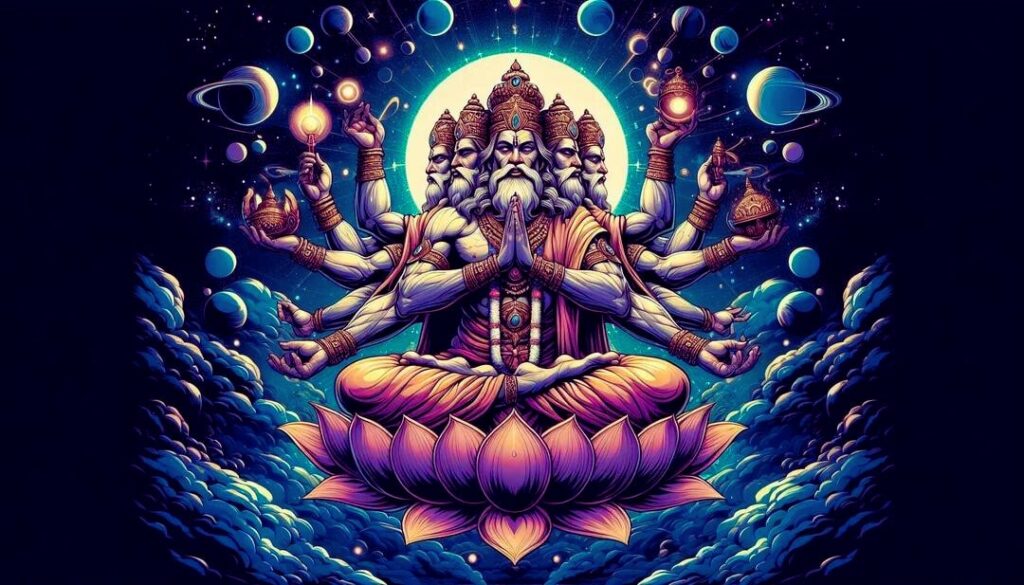
In Hindu iconography, Brahma, the creator god, is depicted with distinctive physical attributes that symbolize his functions and powers:
- Complexion and Faces: Brahma is commonly portrayed with a red or golden complexion, symbolizing his role in creation. He has four heads and faces, each pointing in one of the four cardinal directions, representing his omniscience and the four Vedas, the most sacred Hindu scriptures.
- Beard: He is often shown with a long, white beard, especially in depictions emphasizing his wisdom and the eternal nature of his teachings through the Vedas.
- Arms: Brahma’s iconography usually includes four arms, which signify his omnipresence and omnipotence, as well as his ability to create from all directions.
- Color and Symbols: His skin is often depicted as red, symbolizing both creation and his connection to the earth. The imagery surrounding Brahma includes several symbols, such as the Vedas, which he holds in his hands, and a lotus, which represents the universe emanating from his navel.
These iconographic elements serve not only to identify Brahma but also to convey his attributes and responsibilities within the Hindu pantheon as the creator of the universe.
Symbols Associated with Brahma
In Hindu iconography, several symbols are closely associated with Brahma, each carrying deep symbolic meanings:
- Lotus: The lotus flower, emerging from Brahma’s navel, signifies purity and the creation of the universe. It represents the divine essence and beauty emerging from the chaos of the cosmos. The lotus is a key symbol in depicting Brahma, illustrating his role as the creator in Hindu mythology.
- Swan (Hamsa): The swan, often seen as Brahma’s vahana (vehicle), symbolizes wisdom, discernment, and spiritual perfection. It is said to have the ability to separate milk from water, representing the ability to distinguish between good and evil or the real and the unreal. The swan’s association with Brahma underscores his wisdom and the purity of his creative essence.
These symbols are not just decorative but are imbued with deep philosophical and theological significance, reflecting Brahma’s attributes and his central role in the cosmic order.
Brahma’s Role in Creation
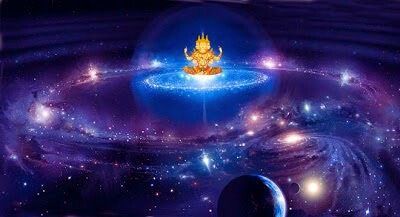
In Hinduism, Brahma’s role as the creator is central to the Trimurti concept, where he, Vishnu, and Shiva represent creation, preservation, and destruction, respectively. Brahma is depicted as the ultimate creator of the universe and all living beings, embodying the aspect of creation in the cosmic cycle. His creation is not a singular event but an ongoing process, where he continuously brings forth life and order from chaos.
The relationship between Brahma, Vishnu, and Shiva is deeply intertwined, symbolizing the balance of creation, preservation, and destruction that governs the universe. While Brahma creates, Vishnu preserves what has been created, ensuring stability and order. Shiva, in turn, is responsible for destruction or transformation, which is essential for the cycle of creation to continue. This cyclical process emphasizes the interdependence of these three deities, highlighting that creation, preservation, and destruction are not isolated acts but part of a greater cosmic balance.
Thus, Brahma’s role and relationship with Vishnu and Shiva illustrate the complexity and dynamism of the universe, where creation is the beginning of a cycle that allows for growth, change, and ultimately renewal.
Worship of Brahma
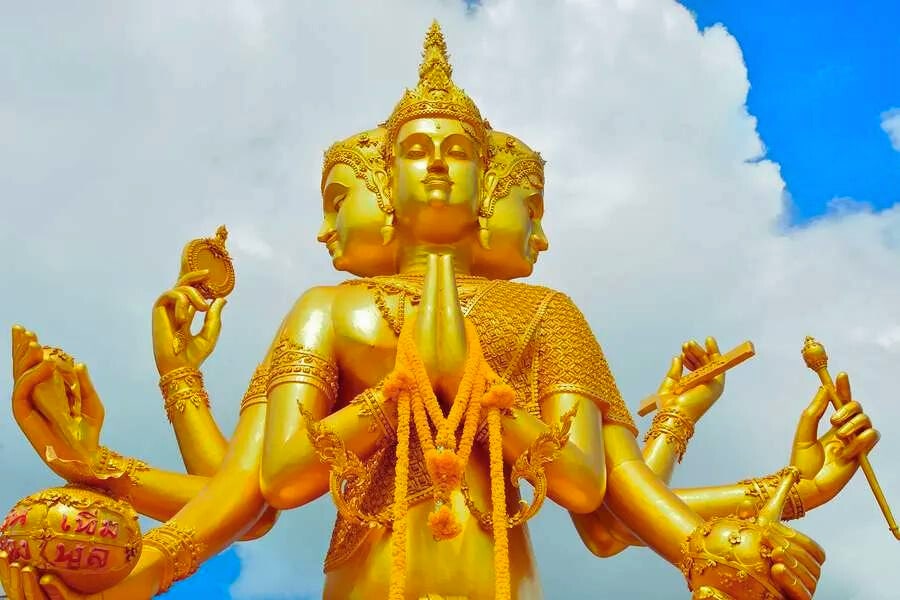
Despite being a part of the Trimurti, Lord Brahma is not widely worshipped in temples or homes. This limited worship contrasts with the significant roles of the other deities in the Trimurti, Vishnu, and Shiva, who have numerous temples dedicated to them across India. The reason behind this anomaly remains rooted in various myths and historical developments within the Hindu tradition.
The most famous temple dedicated to Lord Brahma is located in Pushkar, Rajasthan. It is believed to be one of the very few temples in India where Brahma is the primary deity.
Despite the rarity of his temples, individuals can still worship Lord Brahma, and such practice is considered beneficial, according to some beliefs. The worship rituals and practices dedicated specifically to Brahma are not as widely documented or followed as those for Vishnu and Shiva. The current status of Brahma worship, therefore, remains quite unique within Hinduism, characterized by its scarcity and the specific cultural context of the Pushkar temple.
Temples Dedicated to Brahma
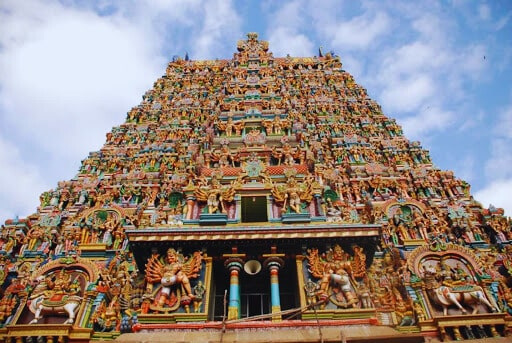
While the Brahma Temple in Pushkar, Rajasthan, is the most famous, there are several other notable Brahma temples in India and potentially in other countries, though specific examples outside of India were not detailed in the provided sources. Here are a few notable ones in India:
- Brahma Temple, Pushkar, Rajasthan: The most famous Brahma temple globally, known for its rarity and significance in Hinduism.
- Asotra Brahma Temple, Barmer, Rajasthan: Another temple dedicated to Lord Brahma located in Rajasthan.
- Brahmapureeswarar Temple, Tirupattur, Tamil Nadu: This temple, though primarily dedicated to Lord Shiva, has a significance associated with Lord Brahma.
- Adi Brahma Temple: Details regarding its location are not specified in the provided sources, but it’s another temple where Brahma is worshipped.
- Brahma Karmali Temple, Panji: Located in Goa, adds to the list of Brahma temples in India.
- Brahma Mandir, Kumbakonam: Another temple in India where Lord Brahma is worshipped.
Although Lord Brahma temples are less common compared to other major deities in Hinduism, these examples showcase the diversity and spread of Brahma worship within India.
Brahma in Other Cultures
Brahma, initially a major deity in Hinduism, experienced a notable shift in reverence when looking from the Indian subcontinent to Southeast Asia. Despite losing some of his prominence in India, Brahma’s influence and worship have continued robustly in Southeast Asia, highlighting a fascinating cultural transfer and adaptation.
- Cultural Influence: Southeast Asia fell within India’s sphere of cultural influence, adopting various aspects of Hindu culture and religion, including the worship of Brahma.
- Integration with Local Beliefs: In countries like Thailand and Cambodia, Hindu rituals and the worship of Hindu gods such as Brahma were practiced alongside the Buddhist faith, showing a unique blend of Hinduism and Buddhism.
- Cultural Theories: Theories suggest that Brahmins (priests in Hinduism) migrated to Southeast Asia, further spreading Indian culture and religious practices, including those related to Brahma.
- Enduring Legacy: Despite Brahma’s diminishing status in India, his worship has not only persisted but also thrived in parts of Southeast Asia, indicating a significant cultural and religious legacy beyond his Indian origins.
Myths Involving Brahma
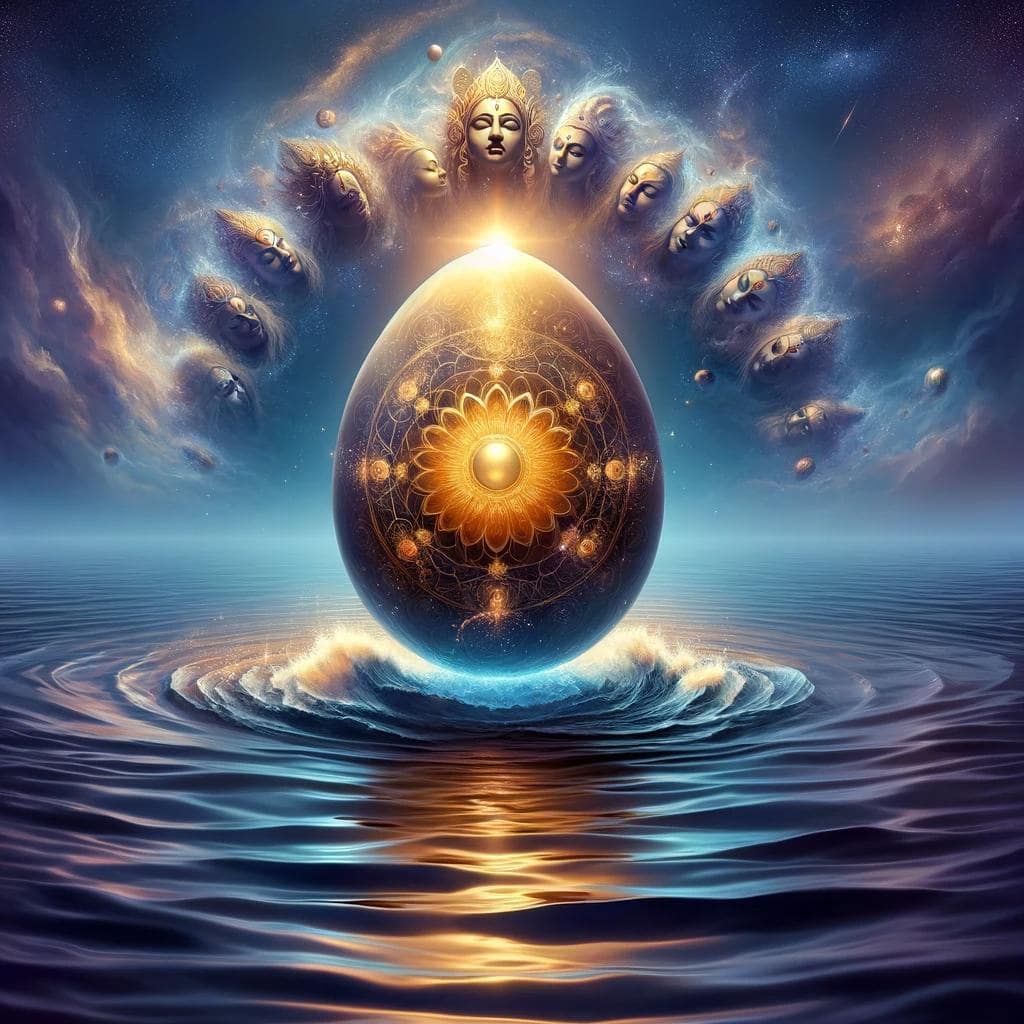
The myths surrounding Lord Brahma, the Hindu god of creation, encapsulate profound teachings and philosophical insights. Here are some notable stories and their underlying meanings:
- Creation and the Cosmic Egg: Brahma is said to have emerged from a cosmic egg and created the world and all beings. This myth underscores the cyclical nature of creation and destruction in Hindu cosmology.
- Brahma’s Four Heads: Originally, Brahma had five heads. The myth of how he lost one to Lord Shiva for lying teaches the value of humility and truthfulness. His four remaining heads, representing the four Vedas and directions, symbolize comprehensive knowledge and awareness.
- The Lotus of Creation: From Brahma’s navel sprang a lotus, upon which sat Lord Vishnu. This story highlights the interconnectedness of the gods within the Trimurti and the collaborative nature of creation, preservation, and destruction.
- Brahma and Saraswati: Brahma created Saraswati, the goddess of wisdom, from his own essence. However, his unwavering attention to her form led to a curse that Brahma would not be worshipped widely on Earth. This myth conveys the dangers of desire and the importance of maintaining focus on one’s spiritual path.
These myths, while diverse, collectively emphasize core values such as humility, wisdom, and the interconnectedness of all existence.
The Trinity Concept
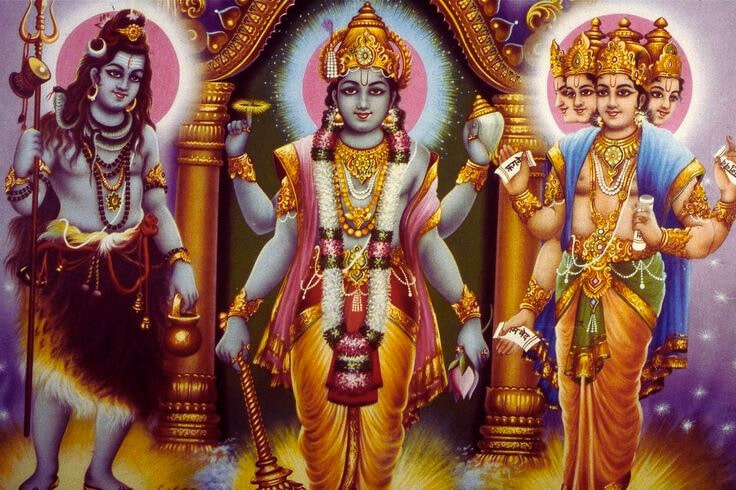
The concept of the Trimurti in Hinduism represents the cosmic functions of creation, preservation, and destruction, personified by the gods Brahma, Vishnu, and Shiva, respectively. This trinity is a fundamental aspect of Hindu philosophy and mythology, encapsulating the dynamic process of the universe’s continual creation, sustenance, and transformation.
- Brahma is the creator, responsible for the formulation of the universe and all living beings. He symbolizes the aspect of creation, initiating the cycle of existence.
- Vishnu represents preservation or sustenance. He is the protector of the universe, maintaining order and balance. Vishnu’s role is to ensure the ongoing stability and harmony of creation, intervening whenever necessary to uphold dharma (righteousness).
- Shiva embodies destruction or transformation. This destruction is not merely an end but a necessary part of the cycle, making way for new creation. Shiva’s role completes the cycle, allowing for renewal and evolution.
Together, these three deities and their functions illustrate the Hindu understanding of the universe as a perpetual, dynamic process. The Trimurti emphasizes the interconnectedness of opposite forces, acknowledging that creation, preservation, and destruction are essential for the cosmos’s eternal renewal.
Philosophical Interpretations
Brahma’s role in cosmic balance within Hindu philosophy is deeply symbolic, embodying the universe’s cycle of creation, which is integral to maintaining cosmic order and balance. As the creator god in the Trimurti, alongside Vishnu (the preserver) and Shiva (the destroyer), Brahma’s function is not just about bringing forth existence but also about setting the stage for the cycle of life, death, and rebirth that underpins Hindu cosmology.
Philosophically, Brahma’s activity represents the beginning of the cosmic cycle that allows for the evolution of consciousness and the universe. This role can be interpreted through the lens of Brahman, the ultimate reality or cosmic spirit, which suggests that creation itself is an expression of the divine consciousness seeking to experience itself in myriad forms.
Moreover, the depiction of Brahma working in tandem with Vishnu and Shiva highlights the interconnectedness and interdependence of creation, preservation, and destruction. These functions are not seen as separate or conflicting but as complementary, ensuring the continual renewal and balance of the cosmos.
Through this philosophical viewpoint, Brahma embodies the beginning of a process that is essential for cosmic harmony, prompting a deeper understanding of life’s cyclical nature and the importance of each phase in the cosmic order.
Modern Relevance
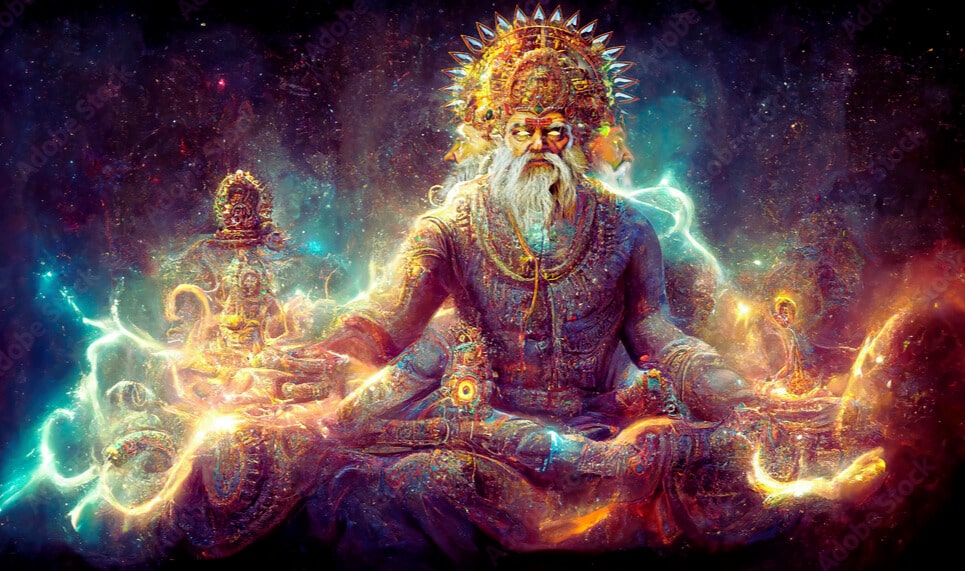
In contemporary life, Brahma’s symbolism, despite his lesser prominence in active worship within Hinduism, carries profound insights for modern individuals and society. His four faces symbolize the comprehensive vision and understanding required to navigate the complexities of the world, urging a multidimensional approach to life’s challenges. Holding a book or a lotus, Brahma embodies the eternal values of knowledge and purity, emphasizing the importance of wisdom and spiritual purity in personal growth and societal advancement.
Moreover, as the creator aspect of the Trimurti, Brahma’s role highlights the importance of creativity and innovation for progress. His connection to the triple world through active creation reflects the dynamic nature of existence and the constant need for renewal and transformation in human endeavors.
Although not widely worshipped today, Brahma’s symbolic significance can inspire a balanced and holistic approach to life, valuing wisdom, creativity, and ethical purity. His representation in contemporary life can be seen as a guide for achieving personal fulfillment and contributing positively to the world’s continual creation and evolution.
Common Misconceptions
Several misconceptions revolve around Lord Brahma, the creator god in Hindu mythology. Here are clarifications on some common misunderstandings:
- Lack of Worship Equals Disrespect: The limited worship of Lord Brahma does not signify disrespect or hatred towards creation. His lesser prominence in daily worship compared to other deities is more a reflection of his role within Hindu cosmology rather than a comment on his importance.
- Misinterpretation of Roles: Despite common beliefs, the Hindu Trinity (Trimurti) of Brahma, Vishnu, and Shiva, representing creation, preservation, and destruction respectively, illustrates the dynamic balance of the universe. Brahma’s role as the creator is not lesser or greater than the roles of Vishnu and Shiva; each is crucial to the cycle of existence.
- Myth of Supreme Power: The belief that Lord Brahma is an all-powerful deity superior to others is a misunderstanding. Hinduism encompasses a broad spectrum of gods and goddesses, each with specific roles and powers. The concept of supreme power is more complex and nuanced, often transcending individual deities.
- Forgotten or Ignored: Although Brahma may not be as prominently worshipped or featured in contemporary Hindu practices, he remains a significant figure in Hindu mythology and philosophy. His contributions and the myths surrounding him continue to be part of Hindu cultural and religious discourse.
Conclusion
Brahma, the Creator within the Hindu Trimurti, embodies the complex and multifaceted nature of Hindu mythology and spirituality. Originating from the early Vedic period, Brahma’s significance has evolved, reflecting changes in religious practices and philosophical understandings. Although his prominence has waned over centuries in favor of deities like Vishnu and Shiva, Brahma’s role as the creator remains a critical aspect of Hindu cosmology. His philosophical importance highlights the value of balance, creativity, and the continuous process of creation and renewal within the universe.
The distinction between Brahma and Brahman further enriches Hinduism’s spiritual landscape. Brahman represents the ultimate, unchanging reality, transcending the limitations of form and time, while Brahma personifies the creative aspect of this cosmic principle. Modern movements, such as the Brahma Kumaris, underscore the enduring relevance of these concepts, demonstrating how ancient teachings continue to influence contemporary spiritual practices.
In conclusion, Brahma’s legacy is a testament to Hinduism’s depth and the religion’s ability to adapt and resonate across different epochs. His story invites reflection on creation, the nature of the divine, and the perpetual cycle of life and renewal.
Read also: What is a Thunder Egg?
